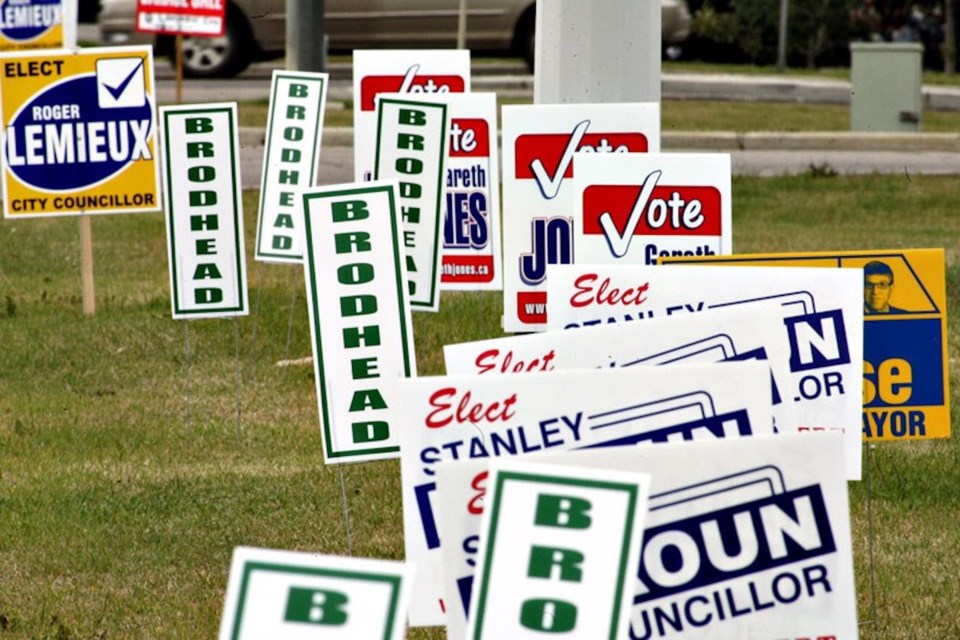Candidates in upcoming elections at every level of government may need to be more diligent about where they put up their signs in St. Albert, as city council has taken the first step in approving a couple of new rules governing election signage.
Amendments to the city's traffic bylaw under consideration would require signs advertising the same candidate, or the same position on a referendum, to be at least 20 metres apart, and to limit where election candidates can place their signs to a list of specific roads.
The bylaw amendments stem from a successful motion put forward by Coun. Mike Killick last fall asking city staff to see whether the city's election signage regulations were up to date and still followed best practices, with a special focus on “achieving greater public safety” and reducing the “environmental impact” of election signs. The amendments were presented to and approved by council's standing committee of the whole on June 11, and will now need to be approved again in an upcoming council meeting.
A third amendment to require candidates to place election signs two metres away from a curb, or from the edge of the roadway if no curb exists, was proposed by administration but voted down by the committee, with Mayor Cathy Heron and Killick wanting to approve the amendment.
Killick said he is pleased with the changes administration brought forward, as he thinks it will make the campaign process a bit more fair as candidates have “limited real estate” to set up signs.
“The whole idea is to stop grouping of putting three or four signs from one candidate all within 10 feet of each other,” Killick said. “We don't need to have multiple signs from the same candidate, let's space them out.”
“Giving everybody a fair chance to get their signs out and share that boulevard space is, I think, the fair way to go.”
When it came to the defeated amendment that would require signs to be two metres from a curb, Killick said he thought this requirement would make it safer for those who actually put the signs up as they wouldn't need to stand as close to the road when doing so, and beneficial for drivers who may have their vision impeded.
During the meeting, several councillors, including Coun. Wes Brodhead and Coun. Natalie Joly, said they hadn't heard any concerns about signs being too close to the road.
“As far as I know this has never been an issue,” said Joly. “I've never heard anyone complain about it [and] I've never heard anyone have concerns about it.”
“It's not a problem in the past and I don't foresee it being a problem in the future.”
A staff report report about the changes, written by city solicitor Bethany Schatz and city transportation manager Dean Schick, says administration thinks both changes approved by the committee would survive a Charter of Rights and Freedoms challenge — something the city “must be mindful” of, given election signage falls under the right of freedom of expression.
“Freedom of expression includes the right to communicate in a visual way ... which is what an election sign does,” Schatz and Schick wrote. “As such, a municipal bylaw that purports to restrict or limit the scope of allowable election signage constitutes a prima facie [or at first sight] infringement of this Charter provision.”
“To be upheld as legally valid, a restriction on one or more freedoms protected under [the Charter] must be both directly related to achieving a public purpose that is substantial and important enough, and as minimally restrictive as possible to achieve that public purpose.”
As both changes “[relate] to achieving the public purposes of greater public safety and reduced environmental impact,” Schatz and Schick wrote, administration thinks the changes would be considered valid by the courts.
“Adding restrictions ... that specify the distance ... from another election sign that is the same ... would likely improve driver sight lines and reduce unnecessary election signage, both of which are substantial and important enough reasons to justify the restrictions,” the report reads.
“Election signs are also temporary, used for a short period of time, and difficult to reuse, all of which present valid environmental concerns.”
The list of approved roads election signs can be set up along, if approved again by council, are: Boudreau Road; Campbell Road; Gervais Road; Giroux Road; Hebert Road; Levasseur Road; McKenney Avenue; St. Albert Trail; Sir Winston Churchill Avenue; and Sturgeon Road.
Municipal election candidates were already limited to setting up signs on these roads, but the policy change would mean candidates in federal and provincial elections will also be limited to those roads moving forward. Schatz and Schick wrote that limiting candidates in all elections to these approved roads rather than just municipal candidates improves the fairness of the policy, and is a necessary change because “there is no valid reason to regulate signage for municipal [and] school elections in any different manner than signage for provincial [and] federal elections.”
This limitation on signs only being allowed on certain roads doesn't apply to residents or businesses who decide to put a candidate's sign on their own property.
The committee heard, in response to a question from Coun. Sheena Hughes, that election candidates wouldn't face any fines for having their signs set up less than 20 metres apart, although the city would contact candidates to say they weren't complying with the bylaw.
“Elections can be pretty dirty and messy, like, people attack signs constantly,” Hughes said. “When you are running for election, sign maintenance is something that people don't realize how much time is spent just trying to keep your signs actually upright.”




